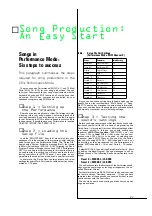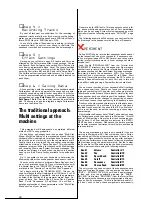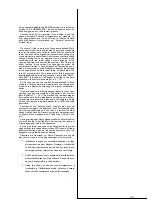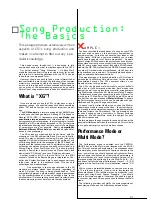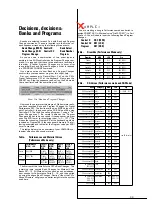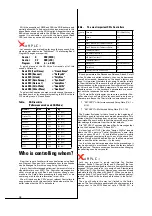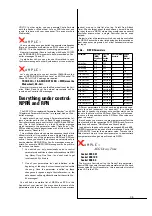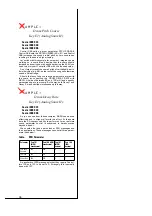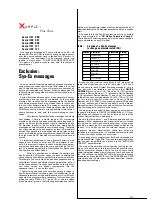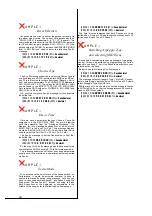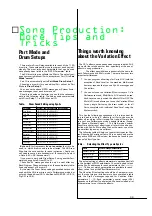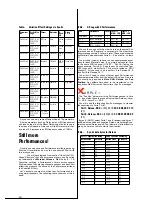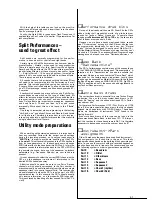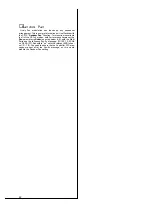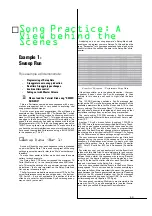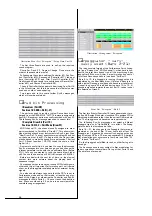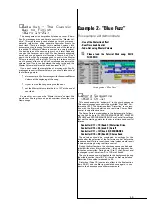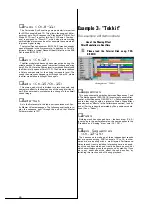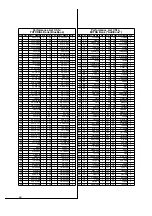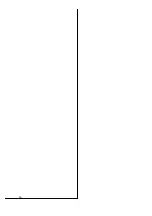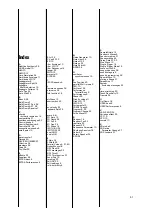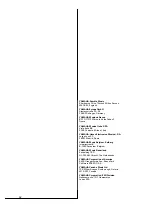
41
With the help of this table you can look up the most fre-
quently used Detune values and insert them into the above
Sys-Ex message (byte 9).
Luckily, the Note Shift (or sequencer Track Transpose, if
applicable) and Pan Position (Controller 10) parameters a far
less complicated.
Split Performances –
used to great effect
Split sounds are normally programmed for live perfor-
mance – a sound each for your left and right hands.
Certain types of Split Performances can however also be
most effective – literally – when used for song production.
There is a simple reason for this: Apart from the obligatory
Reverb and Chorus effects, the CS1x also offers many fabu-
lous Variation Effects, but these may only be used for Layers
1 – 4 whilst Parts 5 – 16 have to go without. It would be a
shame If only one sound could benefit from these effects.
There is a way around this limitation:
All sounds that are to be treated with the Variation Effect
will need to be incorporated into the Performance if at all
possible. This is made possible by using key splits for up to
4 Layers. When controlled externally, a sound can be played
on a 10
Ω
octave range, so each sound can occupy around 2-
3 octaves.
Exactly which sounds you may use for such a Split Perfor-
mance depends very much on the type of effect used. EQ
effects for instance are particularly good for sounds that fea-
ture prominently in your mix, such as bass drums or bass
lines. Delay effects are important to arpeggios, sequences
and hook lines. A Phaser can liven up any pad sound
immensely. More about this can be found in the “Effects”
section.
One thing to remember when programming is that setting
“Var Send = on” equalises Chorus and Reverb Send Levels
for all the Layers. Therefore it is important to try to incorpo-
rate only sounds into a split Performance that fare well with
a single effect level for all Layers.
Utility mode preparations
When working with external sequencers it is important to
hear any recorded Parts with the correct sound settings
during the recording process, so to set your sequencer to
“MIDI Thru”. In order to avoid note ‘doubling’, set the CS1x
to Local off. This effectively disconnects the CS1x keyboard
from its tone generators, i.e. the keyboard now only sends
MIDI information to the sequencer (via MIDI out). In turn the
sequencer sends this information back to the CS1x (MIDI in)
to generate the sound, but any of the sequencer‘s playback
parameters (e.g. Transpose, Velocity) are now taken into
account.
It is not necessary to select the correct MIDI channel on the
CS1x, as the sequencer re-directs all information to the
desired MIDI channels anyway.
Attention should however be paid to the Parts’ Receive
channels, which usually correspond to the Part number. It
may occasionally be useful to deviate from this when a single
sequencer track is to control several Parts. This function can
be useful especially when the CS1x is only a part of a MIDI
equipment setup. In this scenario the CS1x should usually
only receive information on a few specific MIDI channels.
This is achieved by disabling all other unused Parts (RcV Ch.
= off).
❯
Performance drum kits
On top of the already well-known XG Drum Kits the CS1x
adds a further half megabyte‘s worth of up-to-date drum
sounds for Techno, Dance, House etc. To sample these
sounds give Performances 123 to 128 a try. These contain
all of the new drum sounds in 6 kits.
However, as we have already mentioned these sounds
aren‘t “Drum voices” as found in the XG drum kits that can
be programmed individually for each key, but “Normal
voices” that can be assigned to any Layer or Multi Part (5 –
16) like Material Voices. This means of course that they can‘t
be used in XG mode. The necessary Bank/Program change
messages can be found in section “Decisions, decisions …”.
❯
Demo Bank
"Dancemachine"
The CS1x Performances contain many of the sounds found
in the YAMAHA QS-300 software pack “Dancemachine”. A
selection of the “Dancemachine” sounds is available, but
somewhat hidden in an undocumented “Demo Bank” which
was used for the factory demo productions. Luckily these
sounds can be accessed as Material Voices with the follow-
ing Bank/Program changes: MSB 063, LSB 123, Prg 074 to
128. No question about it, these sounds add significantly to
any Techno/Dance armoury.
❯
Dance bass drums
The correct bass drum is essential for every Techno/Dance
production. You can find many typical bass drums in XG
Drum Kit “Analog” and the above mentioned CS1x Perfor-
mance drum kits.
Furthermore, Performances U127 (Dist Kick) and U128
(Euro Kit) contain specialist bass drums that have already
enjoyed much popularity with QS-300 users. These bass
drums are derivatives of instrument “HiQ!” found in the
Analog drum kit.
Even more bass drums of this type can be found in the
above mentioned Demo Bank, in locations 121 – 128. Impor-
tant: the root key for these bass drums is D#1. It is therefore
necessary to transpose a normal bass drum track by -21.
❯
Instrument<Ð>Part
assignment
Other Yamaha synthesizers have used fixed Instrument –
Part assignments for Techno kits in the past. This finally
made productions based on the building block principle pos-
sible, i.e. you could now work with pre-recorded sequences,
grooves, bass and chord lines etc. We recommend you use
the following system in order to guarantee compatibility:
Part 9
= Bass drum
Part 10
= HiHat
Part 11
= Other drums
Part 12
= Bass
Part 13
= Sequence 1
Part 14
= Sequence 2
Part 15
= Chord 1 (rhythm)
Part 16
= Chord 2 (Pad)

